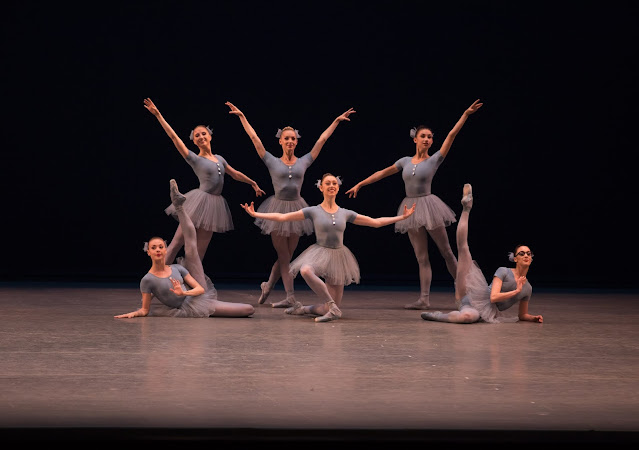Evan Fisk, Zack Gonder, and Stephanie Terasaki of Brian Brooks / Moving Company in
Closing Distance at Jacob's Pillow Dance Festival 2021. Photo by Jamie Kraus
Brian Brooks / Moving Company’s three works at Jacob’s Pillow recently could represent time stamps of periods over the last year and a half. The opening piece, Flight Study (2021) was created primarily during Covid. The eight dancers often moved in a cloud while remaining isolated. Their movements were small in amplitude, traveling little; a foot slid forward a few inches, seemingly propelled by a mere breath. The dancers lay on the stage, taking turns arising to varying heights, evoking waves rolling onto the shore (enhanced by their navy rompers, by Karen Young). Bryce Dessner’s score for strings evoked emotions from anger to contemplation, at times propelling the dancers forward and back. Alone, but together, manipulated by some force as great as the ocean, or perhaps, chillingly, a global pandemic.
Brooks took the stage to perform Quiet Music (2021), a solo to Nico Muhly’s music which provided a change of dynamic as well as time for his company to change costumes in the now de rigeur intermissionless, under-an-hour program. Brooks can often treat dancers—most notably himself—as machine-like vehicles with which to conduct kinetic experiments involving endurance or repetition. Hopping on one leg for minutes at a time, or running relentlessly, or walking on others’ body parts to avoid contact with the floor. Here, there is no such dogma, simply fluid movement traveling from an eeling hand through the torso and head, or a languid arabesque to stretch the body briefly. In a long-sleeve shirt and pants, Brooks assumed an everyman presence somewhat reluctant to explode beyond the confines of his body’s invisible bubble.
The final work, Closing Distance (2020), was made just before Covid hit, and that’s clear in the dancers’ physical interactions and unity in moving as one organism in close ensemble passages. Caroline Shaw’s intriguing score, Partita for 8 Voices, begins with spoken phrases: “To the side, left around…” Are these directions for the dancers? Because they are circling around one another, pushing another’s arm to cause a reaction, clustering around one dancer and clutching her arm, forming a caterpillar-like creature by linking hands with elbows. A performer lowers herself to the floor, which is echoed by each successive dancer like a time-stop photo.
In a key duet, Carlye Eckert floats her hands over a man’s body, eliciting a reaction that resembles the effect of a magnetic field. Even six feet away, as she pushes the air between them, he reacts as if she has cast energy. A closely arranged trio moves essentially as one, with a slight lag between mimicked moves. In the final section, the performers lie parallel to one another, rising a bit, then higher and higher, like a chart of the evolution of homosapiens. They coalesce in a group before lying down to succumb to the invisible force field wielded by Eckert once more. The music, sung by Roomful of Teeth, enchants with closely spaced harmonies, ethereal at times. Young also designed the white-hued costumes of variously fitted and shaped separates.
This program’s breadth symbolized the roller coaster we’ve been through lately, from a pre- and post-pandemic state of normal physical interaction, to being together yet isolated. It departed from many of Brooks’ previous presentations in some ways—less systematic scientific experimentation, and no deliberate choice of signature set or color design typical of years past, perhaps because it was performed on the Leir stage, in front of Massachusetts' verdant Berkshires. But it displays a humanity that beats in the heart of dance, in its varying complexity and potential for expression.
